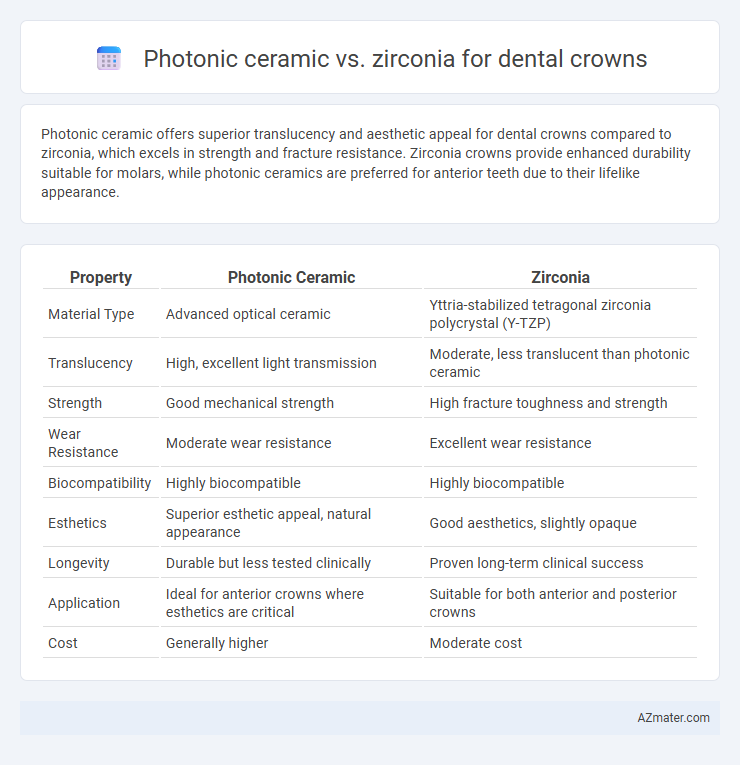Photonic ceramic offers superior translucency and aesthetic appeal for dental crowns compared to zirconia, which excels in strength and fracture resistance. Zirconia crowns provide enhanced durability suitable for molars, while photonic ceramics are preferred for anterior teeth due to their lifelike appearance.
Table of Comparison
| Property | Photonic Ceramic | Zirconia |
|---|---|---|
| Material Type | Advanced optical ceramic | Yttria-stabilized tetragonal zirconia polycrystal (Y-TZP) |
| Translucency | High, excellent light transmission | Moderate, less translucent than photonic ceramic |
| Strength | Good mechanical strength | High fracture toughness and strength |
| Wear Resistance | Moderate wear resistance | Excellent wear resistance |
| Biocompatibility | Highly biocompatible | Highly biocompatible |
| Esthetics | Superior esthetic appeal, natural appearance | Good aesthetics, slightly opaque |
| Longevity | Durable but less tested clinically | Proven long-term clinical success |
| Application | Ideal for anterior crowns where esthetics are critical | Suitable for both anterior and posterior crowns |
| Cost | Generally higher | Moderate cost |
Introduction to Dental Crown Materials
Photonic ceramic and zirconia are prominent materials used in dental crown fabrication, each offering distinct advantages in durability and aesthetics. Zirconia crowns provide exceptional strength and biocompatibility with natural tooth color, making them a preferred choice for posterior restorations. Photonic ceramic crowns utilize advanced light-transmitting properties to enhance translucency and mimic natural enamel, improving the overall appearance of anterior crowns.
Understanding Photonic Ceramics: Composition and Properties
Photonic ceramics used in dental crowns are engineered composites primarily composed of silica, alumina, and zirconia, designed to enhance light transmission and aesthetic appeal. Their unique microstructure offers superior translucency and biocompatibility compared to traditional zirconia, which excels in mechanical strength but often lacks optimal optical properties. Understanding the composition and optical properties of photonic ceramics is crucial for selecting dental crowns that balance durability with natural tooth-like appearance.
Zirconia Crowns: Structure and Advantages
Zirconia crowns consist of a highly durable crystalline structure composed primarily of zirconium dioxide, offering exceptional strength and fracture resistance compared to photonic ceramics. The material's biocompatibility ensures minimal allergic reactions or tissue irritation, making it suitable for long-term dental restorations. With superior opacity and natural tooth color matching, zirconia crowns provide excellent aesthetic outcomes alongside their mechanical advantages.
Aesthetic Comparison: Photonic Ceramic vs Zirconia
Photonic ceramic offers superior translucency and natural tooth-like appearance compared to zirconia, making it ideal for highly aesthetic dental crowns in the anterior region. Zirconia crowns provide excellent strength but often have a more opaque and less lifelike aesthetic, which can limit their use where translucency and color matching are critical. Advances in photonic ceramic technology enable better light diffusion and shade mimicry, enhancing its appeal for patients seeking visually seamless restorations.
Strength and Durability: Performance Under Pressure
Photonic ceramics offer high compressive strength and excellent resistance to fracture, making them reliable for dental crowns subjected to intense biting forces. Zirconia, known for its superior toughness and fracture resistance, provides exceptional durability and maintains integrity under long-term occlusal stress. Both materials excel in strength, but zirconia is often preferred for its proven longevity and resilience in clinical dental applications.
Biocompatibility and Patient Safety
Photonic ceramic and zirconia both offer high biocompatibility for dental crowns, minimizing allergic reactions and tissue irritation. Zirconia is widely recognized for its excellent osseointegration and resistance to bacterial colonization, contributing to long-term patient safety. Photonic ceramic provides enhanced translucency mimicking natural teeth, while maintaining non-toxicity and inert surface properties critical for oral health.
Clinical Applications: Suitability for Different Cases
Photonic ceramics offer superior translucency and aesthetic appeal, making them ideal for anterior dental crowns where natural appearance is critical. Zirconia crowns provide exceptional strength and durability, suitable for posterior restorations and patients with high occlusal forces. Both materials demonstrate biocompatibility and resistance to wear, but choice depends on balancing aesthetic demands with functional requirements in clinical applications.
Marginal Fit and Longevity
Photonic ceramic crowns demonstrate superior marginal fit compared to zirconia, ensuring minimal gaps that reduce bacterial infiltration and subsequent decay. Zirconia offers exceptional longevity due to its high fracture toughness and wear resistance, making it highly durable under occlusal forces. Studies indicate that while photonic ceramics provide excellent esthetics with precise margins, zirconia crowns tend to maintain structural integrity over extended periods, balancing aesthetic demands with functional performance.
Cost Analysis: Affordability and Value
Photonic ceramics generally offer a lower-cost alternative to zirconia for dental crowns, due to less expensive raw materials and simplified manufacturing processes. Zirconia crowns, while more costly, provide superior durability and wear resistance, often translating to longer-lasting restorations with fewer replacements. Evaluating cost-effectiveness involves balancing initial affordability of photonic ceramics against the potential long-term value and performance benefits of zirconia.
Decision Guide: Choosing the Right Material for Dental Crowns
Photonic ceramic and zirconia are prominent materials in dental crowns, each offering unique benefits. Zirconia is favored for its exceptional strength, durability, and biocompatibility, making it ideal for posterior crowns subjected to high biting forces. Photonic ceramic provides superior aesthetics and translucency, closely mimicking natural tooth enamel, making it more suitable for anterior crowns where appearance is critical.

Infographic: Photonic ceramic vs Zirconia for Dental crown
 azmater.com
azmater.com